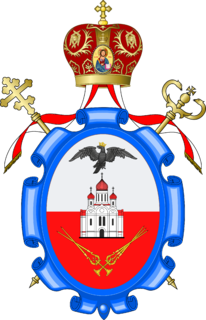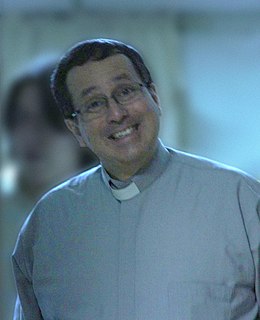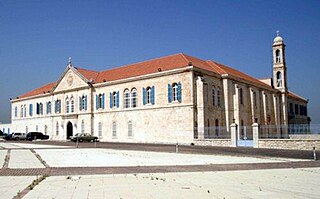
The Eastern Orthodox Church, also called the Orthodox Church, is the second-largest Christian church, with approximately 220 million baptised/baptized members. It operates as a communion of autocephalous congregations, each governed by its bishops and adherents in local synods. The church has no central doctrinal or governmental authority analogous to the Head of the Roman Catholic Church, the Pope, but the Ecumenical Patriarch of Constantinople is recognized by them as primus inter pares and regarded as the spiritual leader of many of the eastern Christian parishes. As one of the oldest surviving religious institutions in the world, the Eastern Orthodox Church has played a prominent role in the history and culture of Eastern and Southeastern Europe, the Caucasus, and the Near East. The Eastern Orthodox Church officially calls itself the Orthodox Catholic Church.

The Eastern Orthodox Church is a communion comprising the fourteen or sixteen separate autocephalous (self-governing) hierarchical churches that recognize each other as canonical (regular) Eastern Orthodox Christian churches.

The Polish Autocephalous Orthodox Church, commonly known as the Polish Orthodox Church, or (Orthodox) Church of Poland is one of the autocephalous Eastern Orthodox churches in full communion. The church was established in 1924, to accommodate Orthodox Christians of Polish descent in the eastern part of the country, when Poland regained its independence after the First World War.

Christianity in Lebanon has a long and continuous history. Biblical Scriptures purport that Peter and Paul evangelized the Phoenicians, whom they affiliated to the ancient patriarchate of Antioch. The spread of Christianity in Lebanon was very slow where paganism persisted especially in the mountaintop strongholds of Mount Lebanon. A 2015 study estimates some 2,500 Lebanese Christians have Muslim ancestry, whereas the majority of Lebanese Christians are direct descendants of the original early Christians.
A canonical territory is, in some Christian denominations, a geographical area seen as belonging to a particular bishop or Church as its own when it comes to ecclesiastical matters. The concept is found both in the Eastern Orthodox and Roman Catholic Churches.

Eastern Orthodoxy in Italy refers to adherents, religious communities, institutions and organizations of Eastern Orthodox Christianity in Italy. In 2014, there were 14 distinctive Eastern Orthodox jurisdictions on the territory of Italy, some of them belonging to canonical Eastern Orthodox churches, while others are classified as independent (noncanonical). First session of the Council of Canonical Orthodox Bishops in Italy was held in 2009.

Spain is not a traditionally Orthodox country, as after the Great Schism of 1054 Christians in the Iberian Peninsula remained in the Catholic sphere of influence.
Iglesia Ortodoxa de Antioquía San Juan Bautista is a Greek Orthodox cathedral in San Pedro Sula, Honduras. The cathedral was founded in 1963, as the first Eastern Orthodox church building in Central America. The cathedral is the sole parish of the Antiochian Orthodox Apostolic Catholic Church of Honduras, which belongs to the Archdiocese of Mexico, Venezuela, Central America and the Caribbean of the Greek Orthodox Patriarchate of Antioch and All the East.

Eastern Orthodoxy in Guatemala refers to adherents, communities and organizations of Eastern Orthodox Christianity in Guatemala. Many of the Eastern Orthodox Christians in Guatemala are ethnic Mayas. Although the dominant religion in Guatemala is historically Roman Catholicism, in recent decades other Christian denominations have gained adherents there. Eastern Orthodox Christianity in particular has been growing rapidly, as a number of schismatic Catholic groups have expressed their desire to become Eastern Orthodox and have been received under the jurisdiction of Eastern Orthodox hierarchs. Currently, there are two distinct Eastern Orthodox communities in Guatemala, the Antiochian and the Constantinopolitan.
The Autonomous Orthodox Metropolis of Ecuador and Latin America is an Old Calendarist jurisdiction which originally comprised the archdiocese in South America and Caribbean of the Ukrainian Autocephalous Orthodox Church in America, subsequently becoming a Metropolis, affiliated to the "Holy Metropolitan Synod of Avlona and Boeotia" in 2010. It is managed by Metropolitan Chrysostom (Celi). It has missions for the area in more than 22 Latin American countries. This is a religious organization recognized by the Ecuadorian government in June 2006. Due to its Old Calendarist status, this jurisdiction is not listed within the diptychs recognized by historical patriarchal sees of the Eastern Orthodox Church, or any church groups in communion with these.

The Serbian Orthodox Eparchy of Buenos Aires, South and Central America is a Serbian Orthodox Church eparchy (diocese) with the main headquarters located in the city of Buenos Aires, Argentina. The diocese has 20 churches in Argentina, Brazil, Chile, Dominican Republic, Venezuela, Ecuador, El Salvador, Colombia and Peru. On October 13, 2012, was realized the first session of diocese under the rule of the actual administration of Metropolitan bishop Amfilohije Radović. The decision of the Holy Assembly of Bishops of the Serbian Orthodox Church brought in May 2018 elected Kirilo Bojović the first Serbian Bishop of Buenos Aires and South-Central America. He was enthroned in the Cathedral church of Nativity of Virgin in Buenos Aires, Argentina, on 4 September 2018.
Maronite Catholic Patriarchal Exarchate of Jerusalem and Palestine is an exarchate of the Maronite Patriarchate of the Maronite Church immediately subject to the Patriarchate of Antioch of the Maronites. In 2017 there were 504 members. It is currently governed by archeparch Moussa El-Hage, OAM.

The Maronite Catholic Patriarchate of Antioch is the seat of the Patriarch of the Maronite Church. It is currently governed by the Patriarch Cardinal Bechara Boutros al-Rahi, OMM.
Oriental Orthodoxy in Guatemala refers to adherents of Oriental Orthodox Christianity in Guatemala. Most of the Oriental Orthodox Christians in Guatemala are ethnic Maya, who are under ecclesiastical jurisdiction of the Syriac Orthodox Church of Antioch.

Luis Fernando Intriago Páez is a secularized priest from Guayaquil. He was parish priest of the Church of Our Lady of Czestochowa from 1996 to 2013. Intriago was dismissed from his priestly functions by the Archdiocese of Guayaquil after there were complaints that Intriago sexually abused and tortured minors. Intriago told his victims that to help themselves and their families, they needed to suffer through a secret sacrifice, which he named the dynamic of sin. The Catholic Church does not approve such rituals.

The Spanish-Portuguese diocese (SPD) or Diocese of Madrid and Lisbon is a diocese of the Russian Orthodox Church (ROC) created on 28 December 2018. The diocese is part of the Patriarchal Exarchate in Western Europe.

The Maronite Church is an Eastern Catholic sui iuris particular church in full communion with the pope and the worldwide Catholic Church, with self-governance under the Code of Canons of the Eastern Churches. Its chief pastor is Patriarch Bechara Boutros al-Rahi since 2011, seated in Bkerke, northeast of Beirut, Lebanon. Officially known as the Syriac Maronite Church of Antioch, it is part of Syriac Christianity by liturgy and heritage.









